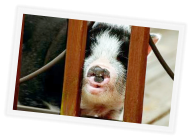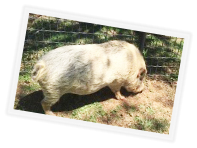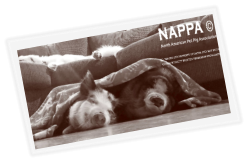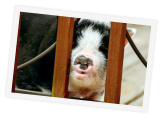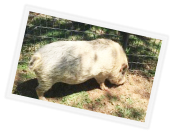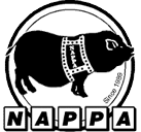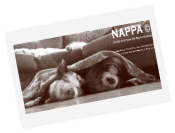BACK TO TOP
FOR MORE INFORMATION, E-MAIL: nappapignews@yahoo.com
2022-2025 Designed by: WimberlysWebWorks.com
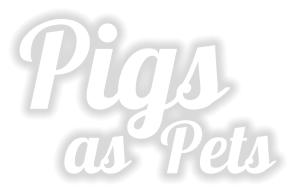
Welcome to The Pet Pig Summit! We are proud to bring together our experts in the overall care and related
issues of the pet pig. The information shared will help to improve the health and wellness of our pigs. By
working together, and teaching new owners the importance of responsible pig parenting, we give homeless
pet pigs a chance to thrive in their forever homes.
Summit Articles:
•
Behavior Issues in Miniature Pigs
•
Nutrition of Potbellied Pigs
•
General Feeding Guidelines for Potbellied and Miniature Pet Pigs
•
Fun & Simple Ways to Train Your Pet Pig
•
Tips for Solving Common Pet Pig Problems
More articles, Please see The Pet Pig Summit Part 2 and The Pet Pig Summit Part 3
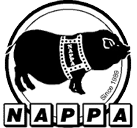


Pet Pig Summit (Part 1)
For More Articles - Please go to
THE PET PIG SUMMIT, PART 2 and THE PET PIG SUMMIT, PART 3 and The Pet Pig Summit Facebook!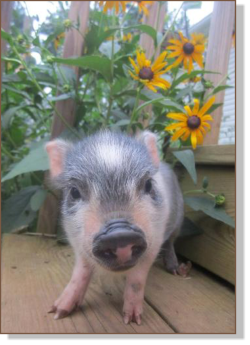
Behavior Issues in Miniature Pigs
Sometimes behavior problems seem overwhelming, but many can be managed with knowledge.
Miniature pigs need to know how to get into a vehicle because chances are they’ll need to be driven
somewhere in their life. They need to know how to get into a crate, they need to let vets and others trim
their feet, they will need to let people weigh them, and they need to be used to the vet exam room.
It’s an important skill set for most pets, and miniature pigs are no exception. Owners need to have
good understanding between people and miniature pigs.
Help with training your miniature pig to become your perfect pet! Miniature pigs can be wonderful
pets, but sometimes there are a couple of behaviors that keep them from being the ideal family member.
Miniature pigs are not dogs. While dogs are predatory in nature, pigs are prey animals, more sensitive
to personal space, which can make them behave aggressively.
Practice patience. Just like us, miniature pigs, learn at different rates. Emphasize praise when your
miniature pig masters a small step and never get angry or force your pig to move at a speed faster than
they can handle. Almost anything you can teach a dog, you can teach miniature pigs. Although they are
not good jumpers, you can teach them to heel, back up, sit and leave it!
Prey animals, such as miniature pigs, tend to be more timid around new things, so you must build up
their trust and confidence. They prefer to stop and think about what is happening before responding.
Please don’t mistake their hesitation for being stubborn or not interested as all intelligent animals are this
way.
Crate training: Start with just the bottom of a crate sitting on the ground. Using a small treat to
encourage your miniature pig is the easiest part of crate training. Once they mastered this part add the
sides of the crate then encourage your miniature pig into the crate again and give them lots of praises.
This part can be a bit trickier walk into the crate. Some miniature pigs are clever and will side-stepping the
crate to go directly for the treat. Once they have figured that out, and the door goes back on, they’ve
accomplished crate training.
Some miniature pigs find the vet visit the hardest. Doorways and thresholds are a sticking point for
many of them and climbing onto a clattery scale is a bit scary. With using a tennis ball on their nose telling
them “stay.” The idea is that a vet will be able to examine them physically, maybe even give them
injections, play with their feet, trim their tusks, that would be a huge accomplishment.
To learn more on how to train your miniature pig please contact Patty H. at pattyrocs@msn.com
Nutrition of Potbellied Pigs
Fresh water should be available at all times to prevent dehydration and salt toxicity (water
deprivation). Balanced diets are essential to provide proper daily nutrients and prevent obesity. The
recommended amount per body weight should be fed divided into at least two meals/day. Green leafy
vegetables, alfalfa, and green grasses (but not weeds, because some are toxic) can be added to the
ration to satisfy appetite. Fruits such as apples and grapes may be given in limited amounts. High
–energy treats should be avoided because PBPs tend to become overweight.
Even when calorie intake is restricted, weight loss is difficult because the minimal amount of exercise
possible in obese PBPs burns few calories. Lameness is another common factor limiting exercise
capacity. Maintaining normal hoof length via trimming is important for motility. Swimming is an
alternative form for obese, lame PBPs, but acclimation and supervision is necessary.
Young weaned PBPs thrive best if adequate colostrum was consumed within the first 24 hr. of life.
PBPs deprived of colostrum easily succumb to diarrheal and septicemic disease. For early nutrition,
commercial milk replacers are available, but 2%-3% pasteurized milk or powdered milk also can be used
successfully. Approximately 1oz. every 4-6 hrs. Should be fed from a bottle with a nipple until the pig is
trained to drink milk from a shallow bowl or pan; usually, this can be done in less than 24 hrs. The
volume fed should increase as the pig grows, but decreased if diarrhea occurs. Overeating diarrhea may
be controlled with kaolin/pectin preparations given every 4 hrs. Infectious diarrhea that may be from
gram-negative bacteria (e.g. Escherichia coli) should respond to parental or oral gentamicin or gradually
increasing ratio of feed to milk (conversion to all feed in 14 days). Increasing amounts of fresh water
should be provided as the diet is converted.
Urolithiasis from triple phosphate crystal luria may occur in PBPs, but can be prevented through
addition of urinary acidifiers to the ration. At least one commercial PBP feed contains ammonium
chloride, and feed additives containing ammonium chloride or citric acid are available. Owners may feed
fruits or vitamin C in an attempt to acidify the urine. A constant source of clean, fresh water is also
important to prevent the accumulation of triple phosphate crystals. Adding fruit juice to water may
increase water consumption and help acidify the urine. Inadequate water consumption by sedentary
PBPs in cool weather has been associated with urolithiasis.
Fun & Simple Ways to Train Your Pet Pig
Because pet pigs are highly intelligent and easily motivated by food and affection, they’re surprisingly
easy to train. Although they aren’t the right pets for everyone, as a responsible pig owner you can
establish good behaviors early on with commands such as” stay”, “come”, and “leave it”. You can also train
your pig to walk on a leash. With some healthy treats and patience, your pig will be trying to impress you
with mastering of new tricks such as “spin”, “sit”, and “shake”.
How to Establish a Training Routine:
Start training your pet pig as early as possible. If you begin training your pig when you bring them
home, you’ll be able to establish good behaviors. You will keep your pig mentally stimulated and engaged
while bonding with your pet pig. Pigs like hierarchical relationships. By training your pig, you can establish
yourself as the leader of the herd.
Train your pet pig every day. Like other intelligent animals, pigs become destructive when they’re
bored. Prevent boredom with a consistent routine that your pet pig can anticipate.
It is a pig’s nature to investigate and forage. Balance your training routine with other “free time”
activities that allow your pet pig to safely explore.
Set a specific time each day to train your pet pig. Plan on implementing your training routine during
specific times of the day. Consider training your pig just before bedtime, to use the last bursts of mental
and physical energy for a good night’s sleep.
Avoid training your pig around mealtimes, generally. When your pet pig is hungry and impatient, they
won’t be motivated to learn tricks. They might even feel provoked and become aggressive. Prioritize
giving your pig a healthy, balanced diet and plenty of fresh water over practicing tricks. Only once your pet
pig has mastered tricks, such as “stay” and “sit” should you practice these around mealtimes.
Pet pigs function well with routines, so if you stick to this schedule, you’re helping your pig to succeed.
Stock your pantry with pig-friendly treats. Pigs are highly motivated by food rewards, which helps
during the training routine. Gather treats to use only during your training routine. Prepare fresh fruits
such as chopped apples and halved grapes. Plain popcorn is another great option, as long as it’s not
salted or buttered.
Follow-up each treat with positive reinforcement. Each time you give a reward, show your pet pig with
some affection. Say things like “good boy/girl or your pig’s name while petting and scratching their favorite
spots. Pigs tend to bond with their owners, so providing lots of attention can help your pig eager to
participate.
Tips For Solving Common Pet Pig Problems
Sometimes pet pigs can suddenly have bad behaviors even pigs who are otherwise on their best
behavior. This could be from a recent move to a new home, an added new pet to the family or
challenging who is top pig of the family. If you see your pig chewing on papers and give them a treat to
distract them from chewing on papers, you have taught your pig the next time they want a treat, all they
have to do is chew on papers.
Prevent Boredom - When a pig has nothing else to do, they might try chewing or tearing up things in
your home. You can be held somewhat responsible for this, as you should be providing your pig with
daily exercise and entertainment. In addition to making sure your pig has enough daily activity, you can
recognize when and why a pig is beginning to start a problem, and then take steps to help them
overcome it.
Aggression - Aggression isn’t always a full out attack. Usually it’s more subtle, but equally dangerous.
Does your pig show sideways body posture, hackles up, chomping mouth, and or high-pitched tones.
These behaviors are normally the early signs of aggression before any biting occurs. Every pig is
different. What to do? Certainly, setting limits, rewarding only positive behavior, not responding
emotionally, and evaluating diet are things you should implement around your home right away. Of
course, reinforcing limits with an aggressive pig can cause the aggression to escalate. There’s basically no
way around it: Because of the potential for serious harm, it’s crucial to begin working with a person who
can help. Finding someone is the first step: Patty Hill with NorthWest Miniature Pig Association is
extremely helpful. Her email address is: pattyrocs@msn.com
Begging - This is a bad habit that is easier to prevent than to stop, so from the very beginning, when
it’s time for you to eat, put your pig in their crate or confine them in a room with an engaging toy to
occupy them. Only let them out when you’re finished.
Helpful Tips:
•
If your pet pig is tipping over a water dish, fasten the dish to a 2x2 or 3x3 piece of plywood. Your pig
must stand on the wood to drink from the dish, and this keeps your pig from tipping it.
•
To help your pet pig with walking down a step or two place 2 or 3 cinder blocks side by side for your
pig can easily walk down the step to walk outside.
•
When summer days heat up place a frozen bottle of water in your pet pigs’ bed to keep them cool
throughout the night. During the day give your pet pig a kids swimming pool or a wallow.
•
Add water-less shampoo to a spray bottle to use on your pet pig. Using a curry brush or a shedding
blade will remove flakes then towel dry & spray your pig with a solution to keep flies away.
•
Recipe for keeping flies away. 8 oz. Avon Skin so Soft (CVS carries product), 1 cup white vinegar, 2
cups of water. Mix all ingredients in a spray bottle. Shake well & spray as needed.
•
Always hose off your pet pig from their feet up if your pig becomes over heated.
•
While pellets should be the staple of a pet pig’s diet, they should not live on pellets alone. A pig
should be allowed free time outside to graze on grass. You can also feed them a variety of fresh produce.
•
Encourage your pet pig to move around. It’s not normal or healthy for a pig to be overweight.
•
Scatter pellets around when feeding your pet pig.
•
Pet pigs also like puzzle toys. Many pet stores sell toys where you can place air popped popcorn (one
piece at a time) inside each puzzle toy.
•
There is no doubt that there is nothing cuter than a potbellied pig, but remember it is also a huge
responsibility. You must be prepared for a pet with the mind of a 3-year-old for its’ entire life. You need to
be sure you have a vet who will see pigs, emergency plans for any kind of natural disasters and someone
who can “pig sit” should you go out of town. These are all things that need to be considered before you
get a pet pig.
•
Your miniature pig won’t stay mini forever.
•
Forget life in a tiny apartment. Access to plenty of outdoor space is not negotiable for pigs, even
miniature pigs.
•
Positive reinforcement is the key to success with most pets, including potbellied pigs. They won’t
respond to force or punishment.
•
Most will be happy to work for small treats such as small pieces of apple.
•
When you are trying to tame a stubborn pig, you may even want to hand-feed them all of their food
since the quickest way to a pig’s heart is through their stomach.
•
Obesity is a common problem so keep treat foods to a minimum and make sure you aren’t over-
feeding your pig during training in addition to offering your pig food at meal times.
•
Be sure to spend time with your pig without giving treats. Otherwise, they may start to expect or
demand food constantly.
•
Keep training sessions short and regular, with breaks to give your pet pig time to rest and develop
the ability to entertain themselves a bit too.
•
To reduce your pet pigs’ juice intake, add less juice to the water each time. They will not notice the
amount of less juice and will eventually drink only water.
•
Helpful way to hide a pill: add it a fig bar.
•
If your pig is being stubborn, and won't let you put on their harness, just lay the harness on the floor
with the neck part closed creating a circle, put food in middle of circle, and when they go for it, put the
harness on.
General Feeding Guidelines for Potbellied and Miniature Pet Pigs
Potbellied pigs and miniature pigs are omnivores, so their natural diet in the wild would include roots,
veggies, nuts, seeds, berries, worms, and insects. Of course, we don’t expect that you feed this diet for
your pigs, but you can feed them a variety of healthy foods. It’s a good idea to feed pigs larger meals twice
a day (breakfast and dinner) and a healthy snack throughout the day. I only feed pigs once in the evening –
and even remove the work larger meal. In the summer there is generally more than enough feed in a
paddock to feed your pig.
Overfeeding your pet pig - One of the most common mistakes people make with their pet pig is
actually giving them too much food. Pigs are determined to eat and eat, and some people try to please
their pigs by feeding them out of guilt especially if they don’t have time to spend with them. Obese pigs
can develop many health issues from being overweight, so please be careful not to over feed your pig,
even though it is tempting.
Recommended foods for pet pigs - Pet pigs do best on a vegetarian diet consisting mostly of
vegetables. Giving a head of cut-up romaine lettuce along with a cup of veggies, plus watered down pig
pellets made specifically for potbellied pigs or miniature pigs. A good amount of pig pellets is ¾ to one cup
twice a day, depending on how many snacks your pig gets and the weight and age of your pig.
When feeding your pig, vary the veggies so your pig doesn’t get bored with their meals and also get a
variety of nutrients. Recommended veggies include lima beans, green beans, sweet potatoes, peas,
peppers and zucchini.
Be careful about salt content in foods you feed your pig, since a diet high in salt can cause bladder
stones and other urinary problems. Canned and frozen vegetables are convenient, but they often have
added salt, so check the ingredients list on the packaging.
Fruit can be offered as treats on occasion, but only once in a while because of the high sugar content.
What you must NEVER feed you pig:
•
Pork meat and products. Keeping them healthy is not giving your pig any pork meat or products.
•
Dog and cat food. Foods made for dogs and cats are too high in protein for miniature pigs and
potbellied pigs.
You will also want to AVOID feeding your pig:
•
Hog or swine feed. If you buy your pellets at a feed store, make sure you get pellets made especially
for potbellied pigs, not farm pigs.
•
Processed human food. Foods such as cereal and crackers can cause dental issues and often contain
high amounts of salt and sugar.
•
Citrus -limit citrus fruits because too much Vitamin C can cause bladder stones, especially in male
potbellied pigs. Note: pigs have no requirement for Vitamin C.
Issues of obesity in miniature or potbellied pigs - It is not natural for pigs to be fat. If they were living
in the wild, pet pigs would be continuously foraging, roaming and rooting while finding something to eat.
All that exercise would prevent them from becoming obese and they would only be eating healthy foods.
The pig should spend 70% of its waking time looking for food.
Obesity can cause discomfort, lack of energy, digestive problems, issues with the hooves and leg
complications. A pig’s legs were not designed to carry excess weight, especially over the shoulder, so an
obese potbellied pig or miniature pig can suffer damage to the tendons, ligaments and joint of the legs.
Fractures to the bones can also occur. Such damage can cause permanent problems, such as arthritis,
even after weight loss.
A pig who becomes obese can also suffer from “mechanical blindness”, which is caused by fat
surrounding the eye and obscuring the pig’s vision. There are degrees of mechanical blindness, depending
on how obese the pig is. Vision is not a pig’s strongest sense. Removing fat surrounding the eyes is
recommended by surgery.
Ways to help your pet pig lose weight - Pigs vary in size, so there’s no correct weight for all pet pigs. A
potbellied pig or miniature pig who is at a healthy weight has a bit of a swayback and a bit of a belly, and
the body of your pig curves inward before their back legs. Consult with your vet if you have concerns
about your pig’s weight and body condition.
Step one in helping your obese pig return to a normal weight is to make vegetable salads for each meal.
Romaine is a good lettuce to use because it has nutrients your pig needs.
Pigs who have been given junk foods probably won’t eat salads right away. To entice a pig to eat all of
their vegetables, try cutting up the lettuce as small as possible and coating the salad with canned
pumpkin, applesauce, a small amount of unsalted peanut butter or a bit of yogurt. Don’t use an excessive
amount of these foods, just enough to make the salad more eatable for your pig. After a week or so,
reduce the amount of coating, after two weeks, try eliminating the coating and see if your pig will still eat
their salad.
Please be patient with your pet pig as they adjust to this healthy diet, and keep in mind that it’s
extremely important for your pig to lose weight gradually. With providing a balanced, low-fat diet, along
with appropriate exercise, your pig can lose weight the healthy way.
When feeding your pig, vary the vegetables so your pig doesn’t get bored with their meals.
Ensure your pig has access to plenty of water and room to exercise.
BACK TO TOP
FOR MORE INFORMATION,
E-MAIL: nappapignews@yahoo.com
2022-2025 Designed by: WimberlysWebWorks.com
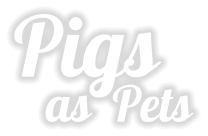
Welcome to The Pet Pig Summit! We are proud to
bring together our experts in the overall care and
related issues of the pet pig. The information
shared will help to improve the health and
wellness of our pigs. By working together, and
teaching new owners the importance of
responsible pig parenting, we give homeless pet
pigs a chance to thrive in their forever homes.
Summit Articles:
•
Behavior Issues in Miniature Pigs
•
Nutrition of Potbellied Pigs
•
General Feeding Guidelines for Potbellied and
Miniature Pet Pigs
•
Fun & Simple Ways to Train Your Pet Pig
•
Tips for Solving Common Pet Pig Problems
More articles, Please see The Pet Pig Summit Part
2 and The Pet Pig Summit Part 3












Pet Pig Summit
(Part 1)
For More Articles - Please go to
THE PET PIG SUMMIT, PART 2 and THE PET PIG SUMMIT, PART 3 and The Pet Pig Summit Facebook!
Behavior Issues in Miniature Pigs
Sometimes behavior problems seem
overwhelming, but many can be managed with
knowledge. Miniature pigs need to know how to get
into a vehicle because chances are they’ll need to be
driven somewhere in their life. They need to know
how to get into a crate, they need to let vets and
others trim their feet, they will need to let people
weigh them, and they need to be used to the vet
exam room.
It’s an important skill set for most pets, and
miniature pigs are no exception. Owners need to
have good understanding between people and
miniature pigs.
Help with training your miniature pig to become
your perfect pet! Miniature pigs can be wonderful
pets, but sometimes there are a couple of behaviors
that keep them from being the ideal family member.
Miniature pigs are not dogs. While dogs are
predatory in nature, pigs are prey animals, more
sensitive to personal space, which can make them
behave aggressively.
Practice patience. Just like us, miniature pigs,
learn at different rates. Emphasize praise when your
miniature pig masters a small step and never get
angry or force your pig to move at a speed faster
than they can handle. Almost anything you can
teach a dog, you can teach miniature pigs. Although
they are not good jumpers, you can teach them to
heel, back up, sit and leave it!
Prey animals, such as miniature pigs, tend to be
more timid around new things, so you must build
up their trust and confidence. They prefer to stop
and think about what is happening before
responding. Please don’t mistake their hesitation for
being stubborn or not interested as all intelligent
animals are this way.
Crate training: Start with just the bottom of a
crate sitting on the ground. Using a small treat to
encourage your miniature pig is the easiest part of
crate training. Once they mastered this part add the
sides of the crate then encourage your miniature
pig into the crate again and give them lots of
praises. This part can be a bit trickier walk into the
crate. Some miniature pigs are clever and will side-
stepping the crate to go directly for the treat. Once
they have figured that out, and the door goes back
on, they’ve accomplished crate training.
Some miniature pigs find the vet visit the
hardest. Doorways and thresholds are a sticking
point for many of them and climbing onto a clattery
scale is a bit scary. With using a tennis ball on their
nose telling them “stay.” The idea is that a vet will be
able to examine them physically, maybe even give
them injections, play with their feet, trim their tusks,
that would be a huge accomplishment.
To learn more on how to train your miniature pig
please contact Patty H. at pattyrocs@msn.com
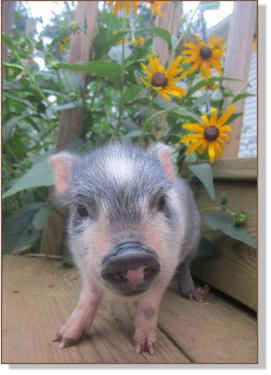
Nutrition of Potbellied Pigs
Fresh water should be available at all times to
prevent dehydration and salt toxicity (water
deprivation). Balanced diets are essential to
provide proper daily nutrients and prevent obesity.
The recommended amount per body weight
should be fed divided into at least two meals/day.
Green leafy vegetables, alfalfa, and green grasses
(but not weeds, because some are toxic) can be
added to the ration to satisfy appetite. Fruits such
as apples and grapes may be given in limited
amounts. High –energy treats should be avoided
because PBPs tend to become overweight.
Even when calorie intake is restricted, weight
loss is difficult because the minimal amount of
exercise possible in obese PBPs burns few calories.
Lameness is another common factor limiting
exercise capacity. Maintaining normal hoof length
via trimming is important for motility. Swimming is
an alternative form for obese, lame PBPs, but
acclimation and supervision is necessary.
Young weaned PBPs thrive best if adequate
colostrum was consumed within the first 24 hr. of
life. PBPs deprived of colostrum easily succumb to
diarrheal and septicemic disease. For early
nutrition, commercial milk replacers are available,
but 2%-3% pasteurized milk or powdered milk also
can be used successfully. Approximately 1oz. every
4-6 hrs. Should be fed from a bottle with a nipple
until the pig is trained to drink milk from a shallow
bowl or pan; usually, this can be done in less than
24 hrs. The volume fed should increase as the pig
grows, but decreased if diarrhea occurs.
Overeating diarrhea may be controlled with
kaolin/pectin preparations given every 4 hrs.
Infectious diarrhea that may be from gram-
negative bacteria (e.g. Escherichia coli) should
respond to parental or oral gentamicin or gradually
increasing ratio of feed to milk (conversion to all
feed in 14 days). Increasing amounts of fresh water
should be provided as the diet is converted.
Urolithiasis from triple phosphate crystal luria
may occur in PBPs, but can be prevented through
addition of urinary acidifiers to the ration. At least
one commercial PBP feed contains ammonium
chloride, and feed additives containing ammonium
chloride or citric acid are available. Owners may
feed fruits or vitamin C in an attempt to acidify the
urine. A constant source of clean, fresh water is
also important to prevent the accumulation of
triple phosphate crystals. Adding fruit juice to
water may increase water consumption and help
acidify the urine. Inadequate water consumption
by sedentary PBPs in cool weather has been
associated with urolithiasis.
Fun & Simple Ways to Train Your Pet
Pig
Because pet pigs are highly intelligent and easily
motivated by food and affection, they’re
surprisingly easy to train. Although they aren’t the
right pets for everyone, as a responsible pig owner
you can establish good behaviors early on with
commands such as” stay”, “come”, and “leave it”.
You can also train your pig to walk on a leash. With
some healthy treats and patience, your pig will be
trying to impress you with mastering of new tricks
such as “spin”, “sit”, and “shake”.
How to Establish a Training Routine:
Start training your pet pig as early as possible. If
you begin training your pig when you bring them
home, you’ll be able to establish good behaviors.
You will keep your pig mentally stimulated and
engaged while bonding with your pet pig. Pigs like
hierarchical relationships. By training your pig, you
can establish yourself as the leader of the herd.
Train your pet pig every day. Like other
intelligent animals, pigs become destructive when
they’re bored. Prevent boredom with a consistent
routine that your pet pig can anticipate.
It is a pig’s nature to investigate and forage.
Balance your training routine with other “free time”
activities that allow your pet pig to safely explore.
Set a specific time each day to train your pet pig.
Plan on implementing your training routine during
specific times of the day. Consider training your pig
just before bedtime, to use the last bursts of
mental and physical energy for a good night’s
sleep.
Avoid training your pig around mealtimes,
generally. When your pet pig is hungry and
impatient, they won’t be motivated to learn tricks.
They might even feel provoked and become
aggressive. Prioritize giving your pig a healthy,
balanced diet and plenty of fresh water over
practicing tricks. Only once your pet pig has
mastered tricks, such as “stay” and “sit” should you
practice these around mealtimes.
Pet pigs function well with routines, so if you
stick to this schedule, you’re helping your pig to
succeed.
Stock your pantry with pig-friendly treats. Pigs
are highly motivated by food rewards, which helps
during the training routine. Gather treats to use
only during your training routine. Prepare fresh
fruits such as chopped apples and halved grapes.
Plain popcorn is another great option, as long as
it’s not salted or buttered.
Follow-up each treat with positive
reinforcement. Each time you give a reward, show
your pet pig with some affection. Say things like
“good boy/girl or your pig’s name while petting and
scratching their favorite spots. Pigs tend to bond
with their owners, so providing lots of attention
can help your pig eager to participate.
Tips For Solving Common Pet Pig
Problems
Sometimes pet pigs can suddenly have bad
behaviors even pigs who are otherwise on their
best behavior. This could be from a recent move to
a new home, an added new pet to the family or
challenging who is top pig of the family. If you see
your pig chewing on papers and give them a treat
to distract them from chewing on papers, you have
taught your pig the next time they want a treat, all
they have to do is chew on papers.
Prevent Boredom - When a pig has nothing else
to do, they might try chewing or tearing up things
in your home. You can be held somewhat
responsible for this, as you should be providing
your pig with daily exercise and entertainment. In
addition to making sure your pig has enough daily
activity, you can recognize when and why a pig is
beginning to start a problem, and then take steps
to help them overcome it.
Aggression - Aggression isn’t always a full out
attack. Usually it’s more subtle, but equally
dangerous. Does your pig show sideways body
posture, hackles up, chomping mouth, and or high-
pitched tones. These behaviors are normally the
early signs of aggression before any biting occurs.
Every pig is different. What to do? Certainly, setting
limits, rewarding only positive behavior, not
responding emotionally, and evaluating diet are
things you should implement around your home
right away. Of course, reinforcing limits with an
aggressive pig can cause the aggression to
escalate. There’s basically no way around it:
Because of the potential for serious harm, it’s
crucial to begin working with a person who can
help. Finding someone is the first step: Patty Hill
with NorthWest Miniature Pig Association is
extremely helpful. Her email address is:
pattyrocs@msn.com
Begging - This is a bad habit that is easier to
prevent than to stop, so from the very beginning,
when it’s time for you to eat, put your pig in their
crate or confine them in a room with an engaging
toy to occupy them. Only let them out when you’re
finished.
Helpful Tips:
•
If your pet pig is tipping over a water dish,
fasten the dish to a 2x2 or 3x3 piece of plywood.
Your pig must stand on the wood to drink from the
dish, and this keeps your pig from tipping it.
•
To help your pet pig with walking down a step
or two place 2 or 3 cinder blocks side by side for
your pig can easily walk down the step to walk
outside.
•
When summer days heat up place a frozen
bottle of water in your pet pigs’ bed to keep them
cool throughout the night. During the day give
your pet pig a kids swimming pool or a wallow.
•
Add water-less shampoo to a spray bottle to
use on your pet pig. Using a curry brush or a
shedding blade will remove flakes then towel dry &
spray your pig with a solution to keep flies away.
•
Recipe for keeping flies away. 8 oz. Avon Skin
so Soft (CVS carries product), 1 cup white vinegar, 2
cups of water. Mix all ingredients in a spray bottle.
Shake well & spray as needed.
•
Always hose off your pet pig from their feet up
if your pig becomes over heated.
•
While pellets should be the staple of a pet
pig’s diet, they should not live on pellets alone. A
pig should be allowed free time outside to graze on
grass. You can also feed them a variety of fresh
produce.
•
Encourage your pet pig to move around. It’s
not normal or healthy for a pig to be overweight.
•
Scatter pellets around when feeding your pet
pig.
•
Pet pigs also like puzzle toys. Many pet stores
sell toys where you can place air popped popcorn
(one piece at a time) inside each puzzle toy.
•
There is no doubt that there is nothing cuter
than a potbellied pig, but remember it is also a
huge responsibility. You must be prepared for a
pet with the mind of a 3-year-old for its’ entire life.
You need to be sure you have a vet who will see
pigs, emergency plans for any kind of natural
disasters and someone who can “pig sit” should
you go out of town. These are all things that need
to be considered before you get a pet pig.
•
Your miniature pig won’t stay mini forever.
•
Forget life in a tiny apartment. Access to
plenty of outdoor space is not negotiable for pigs,
even miniature pigs.
•
Positive reinforcement is the key to success
with most pets, including potbellied pigs. They
won’t respond to force or punishment.
•
Most will be happy to work for small treats
such as small pieces of apple.
•
When you are trying to tame a stubborn pig,
you may even want to hand-feed them all of their
food since the quickest way to a pig’s heart is
through their stomach.
•
Obesity is a common problem so keep treat
foods to a minimum and make sure you aren’t
over-feeding your pig during training in addition to
offering your pig food at meal times.
•
Be sure to spend time with your pig without
giving treats. Otherwise, they may start to expect
or demand food constantly.
•
Keep training sessions short and regular, with
breaks to give your pet pig time to rest and
develop the ability to entertain themselves a bit
too.
•
To reduce your pet pigs’ juice intake, add less
juice to the water each time. They will not notice
the amount of less juice and will eventually drink
only water.
•
Helpful way to hide a pill: add it a fig bar.
•
If your pig is being stubborn, and won't let you
put on their harness, just lay the harness on the
floor with the neck part closed creating a circle, put
food in middle of circle, and when they go for it,
put the harness on.
General Feeding Guidelines for
Potbellied and Miniature Pet Pigs
Potbellied pigs and miniature pigs are
omnivores, so their natural diet in the wild would
include roots, veggies, nuts, seeds, berries, worms,
and insects. Of course, we don’t expect that you
feed this diet for your pigs, but you can feed them
a variety of healthy foods. It’s a good idea to feed
pigs larger meals twice a day (breakfast and
dinner) and a healthy snack throughout the day. I
only feed pigs once in the evening – and even
remove the work larger meal. In the summer there
is generally more than enough feed in a paddock
to feed your pig.
Overfeeding your pet pig - One of the most
common mistakes people make with their pet pig
is actually giving them too much food. Pigs are
determined to eat and eat, and some people try to
please their pigs by feeding them out of guilt
especially if they don’t have time to spend with
them. Obese pigs can develop many health issues
from being overweight, so please be careful not to
over feed your pig, even though it is tempting.
Recommended foods for pet pigs - Pet pigs do
best on a vegetarian diet consisting mostly of
vegetables. Giving a head of cut-up romaine
lettuce along with a cup of veggies, plus watered
down pig pellets made specifically for potbellied
pigs or miniature pigs. A good amount of pig
pellets is ¾ to one cup twice a day, depending on
how many snacks your pig gets and the weight and
age of your pig.
When feeding your pig, vary the veggies so your
pig doesn’t get bored with their meals and also get
a variety of nutrients. Recommended veggies
include lima beans, green beans, sweet potatoes,
peas, peppers and zucchini.
Be careful about salt content in foods you feed
your pig, since a diet high in salt can cause bladder
stones and other urinary problems. Canned and
frozen vegetables are convenient, but they often
have added salt, so check the ingredients list on
the packaging.
Fruit can be offered as treats on occasion, but
only once in a while because of the high sugar
content.
What you must NEVER feed you pig:
•
Pork meat and products. Keeping them
healthy is not giving your pig any pork meat or
products.
•
Dog and cat food. Foods made for dogs and
cats are too high in protein for miniature pigs and
potbellied pigs.
You will also want to AVOID feeding your pig:
•
Hog or swine feed. If you buy your pellets at a
feed store, make sure you get pellets made
especially for potbellied pigs, not farm pigs.
•
Processed human food. Foods such as cereal
and crackers can cause dental issues and often
contain high amounts of salt and sugar.
•
Citrus -limit citrus fruits because too much
Vitamin C can cause bladder stones, especially in
male potbellied pigs. Note: pigs have no
requirement for Vitamin C.
Issues of obesity in miniature or potbellied
pigs - It is not natural for pigs to be fat. If they were
living in the wild, pet pigs would be continuously
foraging, roaming and rooting while finding
something to eat. All that exercise would prevent
them from becoming obese and they would only
be eating healthy foods. The pig should spend 70%
of its waking time looking for food.
Obesity can cause discomfort, lack of energy,
digestive problems, issues with the hooves and leg
complications. A pig’s legs were not designed to
carry excess weight, especially over the shoulder,
so an obese potbellied pig or miniature pig can
suffer damage to the tendons, ligaments and joint
of the legs. Fractures to the bones can also occur.
Such damage can cause permanent problems,
such as arthritis, even after weight loss.
A pig who becomes obese can also suffer from
“mechanical blindness”, which is caused by fat
surrounding the eye and obscuring the pig’s vision.
There are degrees of mechanical blindness,
depending on how obese the pig is. Vision is not a
pig’s strongest sense. Removing fat surrounding
the eyes is recommended by surgery.
Ways to help your pet pig lose weight - Pigs
vary in size, so there’s no correct weight for all pet
pigs. A potbellied pig or miniature pig who is at a
healthy weight has a bit of a swayback and a bit of
a belly, and the body of your pig curves inward
before their back legs. Consult with your vet if you
have concerns about your pig’s weight and body
condition.
Step one in helping your obese pig return to a
normal weight is to make vegetable salads for each
meal. Romaine is a good lettuce to use because it
has nutrients your pig needs.
Pigs who have been given junk foods probably
won’t eat salads right away. To entice a pig to eat
all of their vegetables, try cutting up the lettuce as
small as possible and coating the salad with
canned pumpkin, applesauce, a small amount of
unsalted peanut butter or a bit of yogurt. Don’t use
an excessive amount of these foods, just enough
to make the salad more eatable for your pig. After
a week or so, reduce the amount of coating, after
two weeks, try eliminating the coating and see if
your pig will still eat their salad.
Please be patient with your pet pig as they
adjust to this healthy diet, and keep in mind that
it’s extremely important for your pig to lose weight
gradually. With providing a balanced, low-fat diet,
along with appropriate exercise, your pig can lose
weight the healthy way.
When feeding your pig, vary the vegetables so
your pig doesn’t get bored with their meals.
Ensure your pig has access to plenty of water
and room to exercise.
